Displaying items by tag: Flying fifteen
National Yacht Club Flying Fifteens Head for Mallorca By Car Transporter
#flyingfifteen – A fleet of seven Dublin Bay Flying Fifteen keelboats on a load measuring over 50–foot long and 12–foot high are on their way to the European Championships in Mallorca, Spain. The extra long load is the result of an innovative class plan to cut travel costs on the 2300–km journey by shipping the entire fleet by car transporter. The road trip is expected to take 30–hours or more.
The National YC sailors fly out this weekend for the regatta that starts next Monday at Reial Club Nautic de Pollensa in the north of the Balearic island. An international fleet of 40 is expected to contest the biennial event.
Strangford Locals Win Flying Fifteen Irish Title By a Single Point
#flyingfifteen – Strangford locals Andy McCleery and Colin Dougan won the 2014 Flying Fifteen Irish title at Portaferry Sailing club today by a single point but it was not until the final race of the six race series did the Killyleagh duo clinch the keelboat cup. Overall results are downloadable below as a jpeg file.
Dublin Bay's David Gorman and Chris Doorly made the best of Strangford's fickle north–westerlies on Saturday with some consistent sailing to be overnight leaders after four races.
Local skippers Peter Lawson and Brian McKee also proved consistent in races that featured forty degree windshifts or more and were in Sunday's shake–up for the top spot in one of Ireland's leading one design classes.
As it turned out, McCleery and Dougan took two final race wins on Sunday, enough it turned out to take the title North from Dun Laoghaire holders Ian Mathews and Keith Poole who finished 19th.
Going into Race 6, it was to be winner takes all between Dun Laoghaire pairing Dave Gorman & Chris Doorly (NYC) and local Killyleagh boys Andrew McCleery & Colin Dougan (KYC). After a long weekend of sailing in a variety of conditions tensions were high in the prestart, after a bit of cat and mouse the gun went with both boats close to the pin end but McCleery was to weather- general recal! All to do again now with a black flag up. The wind had shifted slightly to the right and Gorman had a good start at the committee boat end, this also gave him the option of taking off in the shifts, McCleery was down the line below him. McCleery came across to the right and did a few tacks up the middle but was covered by Gorman. Other boats went out to the left and to the right but it was the middle that actually paid with local Portaferry man Seamus Byers leading at the weather mark with Gorman second, Logan third and McCleery fourth. Gorman got held up at the gybe mark and eventually got over Byers to move into the lead as McCleery moved into second place on the reach, it was now the top two fighting it out at the front!
On the next beat both went to the right out of the strong tide, tack for tack Gorman covered and stayed ahead going down the run. Into the last beat, still the cover was on but it was close as Gorman was only a few boat lengths to weather but it was enough for now. Within 100 meters of the weather mark both tacked out to the apparently stronger wind, the wind pressure was very up and down on this beat, there were local gusts and patchy light areas. Suddenly there was a big knock and McCleery tacked to be above Gorman, opportunity taken! Rounding the weather mark it was McCleerys red and white spinnaker first with Gorman just a boat length behind, around the gybe mark Gorman was to weather, there was still a chance if he could get inside at the leeward mark but alas it wasn't to be, McCleery crossed the line to take the gun and the trophy in dramatic circumstances. It was their first time winning this trophy after many years getting very close and they were deserving winners. Previous winners Gorman & Doorly live to fight another day.
Further back the Lawsons were having a similar dual with McKee and it was the Lawsons who came third in race 6 and third in the regatta. David Mulvin & Ronan Beirne (NYC) also had a great event and won the Silver fleet.
Race 1 was sailed on Friday with 29 boats at the start line, a windward leeward course was a strange affair, with the winds from the NW, the tide was going in and out at the same time depending where you were! Shortly after the start the winds died, those on the right with the tide with them seemed to be cleaning up, what to do? Some cut their loses and tried to get over but to no avail and were spat out the back door, others on the left just stayed and hoped something would come. To make matters worse it was very difficult to actually see the weather mark. The breeze came along the shore after a long wait, Gorman was in a good position with the Meagher but local boys Logan and Lawson got closest to the shore and got the wind and to the weather mark first. It stayed Logan first, Lawson second, Gorman third, McCleery fourth and the Meaghers fifth.
Race 2 on Saturday also had winds from the NW. Gorman got a good start and tacked out to the strong tide, taking some good shifts he built up a good lead from McCleery and Lawson. This is how it stayed till the last beat, dark menacing clouds were looming and the sea was getting rough. Most boats were out on the right but McKee and Lavery went left towards the Killyleagh shore. Gorman arrived at the weather mark after increasing his lead over McCleery, to strong winds and heavy rain. On the reach the visibility was poor and the mark couldn't be seen, the spinnaker was up and it was a full plane down, finding the gybe mark it was a reach to the finish to take the gun. McKee was second with Lavery third and McCleery fourth. It was a long way back to the others as the localised stormed had passed through and they drifted slowly to the finish line.
Race 3 was close, Gorman and McCleery were at the weather mark but McCleery jybed just before the wing mark to get inside and lead, there was no hurry for Gorman as there were still two laps to go. At the leeward mark the winds were light and to the surprise of all the course was shortened so it finished with McCleery first, Gorman a close second, the Meaghers a fantastic third and brother and sister act Peter and Jo Lawson fourth.
Race 4 the winds had settled or so we thought. After a great start Shane McCarthy got his nose in front and stayed there, up the first beat McCleery was second but Gorman had gone left and suffered coming into the weather mark in about tenth position. Down the run not a lot change but on the next beat many boats went left, strange as it didn't pay on the first beat. Shane covered them all but Lawson and Gorman went right and after a while the wind shifted to lift them up to the mark ahead of all those on the left! Shane won, followed by McKee. Lawson, Gorman and the Meaghers.
So overnight it was Gorman leading from McCleery and Lawson on equal points with the Meaghers and McKee tied in fourth place. A great meal was put on by the club that night and tales of an interesting day on the Lough were exchanged into the early hours.
What would Sunday bring, nothing in Strangford Lough is straight forward and anything could happen. The forecast was for little or no wind and that was the case for the morning but it was to fill in from the SE later. After arriving at the race area assisted only by the tide the wind did come in and the PRO soon got Race 5 going with a windward/ leeward course. McCleery hit the left side and got into a quick lead followed by Shane McCarthy and then Gorman. The wind was steady but there were small shifts, on lap two Gorman went out left and into the tide, quickly they went back but McKee and Willis had slipped through. This was how it stayed. McCleery and Gorman were both on 10 points going into the last race.
There is always a great welcome at Portaferry Sailing Club, many thanks to the members and volenteers for making a success of the event. Also thanks to the PRO and his team on managing the event in difficult conditions and getting a full programme of races in. Congratulation to Andrew and Colin on winning.
#flyingfifteen – The Flying Fifteen Championships of Ireland take place in Portaferry Sailing Club on Strangford Lough tomorrow. Up to 30 boats are expected with boats travelling from four sailing centres across Ireland; Antrim, Carlingford, Dun Laoghaire and Dunmore East.
Reigning National champions Ian Mathews & Keith Poole of Dun Laoghaire will be one of the favourites. Local knowledge is expected to play a deciding role. Class President Roger Chamberlain from the lough is in great form and won the recent Northern Championships. Brian McKee and the David McClery and Colin Dougan combination are as consistent as ever as are Peter Lawson and Shane Carty from the local Portaferry Sailing Club.
Also from Dun Laoghaire previous winners David Gorman and Chris Doorly, National YC (NYC) and John Lavery and David O'Brien (NYC) will also be competing.
The Northern Ireland venue featured last week in WM Nixon's Sailing blog: Strangford Lough Sailing Secrets Revealed.
Strangford Lough Sailing Secrets Revealed
#strangfordlough – Strangford Lough is one of Ireland's most important sailing locations, yet it is surprising how few sailors from other areas have savoured its unique attractions. W M Nixon tries to explain why this is so, and delves into the racing enjoyed this week by two very different classes of boats on an alluring and secret water.
Strangford Lough is a very private and hidden sort of place, whether by sea or land. Prehistoric voyagers through the Irish Sea will only have guessed and wondered at the possible existence nearby of this huge salt water lake if they happened to be near the approaches to the narrow entrance during the six hours in twelve when the ebb flows, pouring out of the lough with such vigour that the turbulence can push two or three miles out to sea. And on land, even with today's road system much of Strangford Lough remains hidden from sight.
For sure, you can have fine clear views if you happen to be driving along the road on the lough's eastern shore between Newtownwards and Kircubbin, seeing clear across the water to the lough's islands and rolling coastal hills, and beyond towards the purple peaks of the Mountains of Mourne.
But those vistas only flatter to deceive. The most intricate interaction between sea and land is largely unseen. This is along the lough's western shore, where the drumlin country which defines much of County Down becomes a remarkable pattern of sea and islands. Very occasional glimpses of the sea – inevitably with some boats moored on it in a sheltered and private looking spot – is all that the curious sightseer on land will get for his trouble.
This continually surprising if occasionally frustrating inlet is 15 nautical miles long by six miles wide. The Narrows, which feed it twice daily with a huge surge of tide from the Irish Sea, are 8 miles in length, but less than half a mile wide at their most constricted section at Bankmore Point, where the streams can run at better than eight knots and the neighbourhood whirlpool, forming just when you're thinking it doesn't really exist, is called the Routen Wheel.
While the similarly swift tides which flow through the entrance of the Morbihan in southern Brittany can become something of a small boat playground in summer, Strangford Narrows has a more serious image as the overfalls on the ebb to seaward are a much more challenging proposition. Nevertheless it's fun to sail much of it on the fair tide, and in going into the lough with the tide under you, even in ancient craft you find you're beating at better than ten knots over the ground, the VMG is jet propelled, and soon you're swooshed into a miniature cruising paradise with a myriad of islands – 365 of course - and a wide range of overnight options.
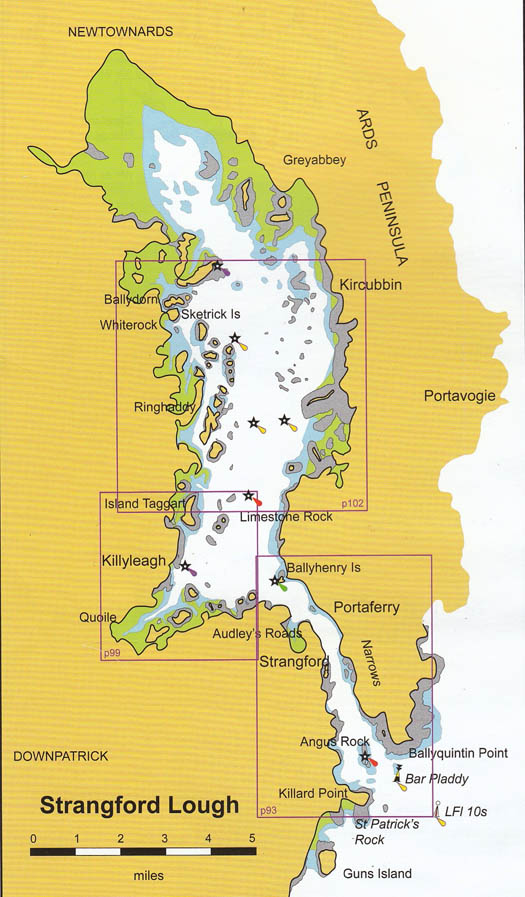
The secret place – despite its substantial size, Strangford Lough remains a mystery to a surprisingly large number of sailors. Courtesy Irish Cruising Club

Strangford Lough's western shore provides tantalising glimpses of sea and islands, usually with boats moored in a snug spot. Photo: W M Nixon
But even when you arrive at the lough by this much-preferred option of being on a boat, there's still that slight sense of intruding on a private place. While Portaferry on the east side of the narrows may present a traditional welcoming façade, and Strangford village to the west is its own charming little self, of the other towns on the lough only Kircubbin halfway up the eastern shore has anything vaguely resembling a waterfront. The lough's biggest township, Killyleagh on the west shore, may have a modern recently-developed waterfront. But that's a private enterprise thing, the town's main street is at some remove from the shore, while other urban centres in the Strangford Lough area such as Downpatrick, Killinchy, Comber, Newtownards and Greyabbey may be near the sea, but they're not of it.
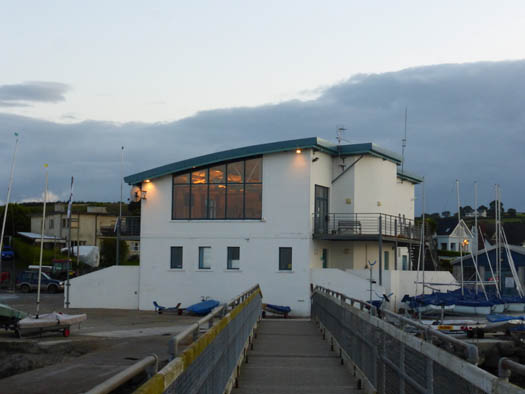
The lough's premier club is the Strangford Lough YC at Whiterock, where this "new" building has been serving members' needs for a dozen years now. Photo: W M Nixon

The view from within. Though the SLYC building may present a utilitarian appearance, its main room is successfully multi-purpose as lounge, dining room and bar, and the view from it is of a comfortable anchorage ready for sailing. Photo: W M Nixon
Yet the lough is home to hundreds of boats, serviced both by private facilities and something like eleven different boat, yacht and sailing clubs. But most of them are along that complex western shore where, in choice locations, the big landowners who had made their money in Belfast's boom days from 1850 to 1912 were so keen to preserve their privacy that they made sure there were no road signs on the few narrow public roads approaching their substantial houses near the shore.
Some years ago, there was an official attempt to liberalise this with a sprinkling of signs, but a visit this week showed that many of them had somehow disappeared, or become invisible under the verdant growth which is fundamental to this heart of the County Down. So more than a smidgin of local knowledge is needed if you wish to access the sailing in this maritime wonderland. But if you can do so, the sport is wonderful if racing around islands and in wayward yet manageable currents is your thing, while there's enough open space in mid-lough to provide a clear venue for major open events, even if it can involved a bit of a sea trek from the shore base at some hidden club.
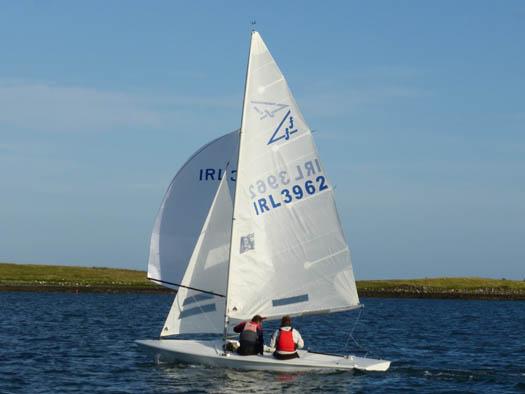
A Flying Fifteen in action at Whiterock off Strangford Lough YC, which has produced F/F Champions to world level.
The active sailing scene in Strangford Lough has produced champions to world level over the years, most notably in the Flying Fifteen class where Strangford Lough sailing surnames such as Carson, Brown, Andrews and McCann have been inscribed on the top trophies down the decades. Thus there's a sense of history in the making with this year's Irish F/F Championship being staged in six days time from August 22nd to 24th by Portaferry Sailing Club at the southeast corner of the lough, where it will be interesting to see how far north they have to go in order to get clear of the fierce tides which flow close past the club's headquarters near Portaferry Marina beside The Narrows.
Meanwhile, this week we'd the chance on Strangford Lough to suss out the racing in two classes which may seem very different, yet each emerged from a clearcut initial requirement which now seems very remote.
The River Class boats at the lough's premier club, Strangford Lough YC at Whiterock on the west shore near Killinchy, really are the area's best kept secret. This is quite an achievement in an ultra-private place like Strangford Lough. Everyone involved with the Rivers knows so much about them that they assume the rest of the world does too. But surprisingly few outsiders know that in the inner reaches of Strangford Lough, they race a class of handsome Alfred Mylne-designed 29ft one design sloops which yield to no-one for classic good looks.
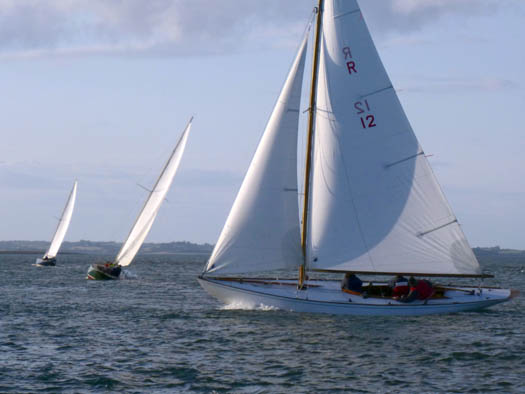
The Mylne-designed 29ft River Class combine classic good looks with real sailing power. Photo: W M Nixon
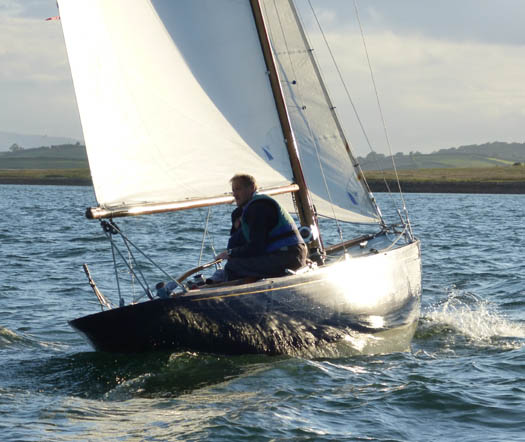
As usual, River Class champion Kenny Smyth has to look astern to see how the opposition is doing. Photo: W M Nixon
Their origins date back to 1919, when some northern sailing people started exchanging ideas about the need for an easily-handled simple sloop "which could be sailed by a man and his daughters". At first glance, this seems like a welcome and liberal requirement, fuelled by the emergence of the suffragette movement seeking votes and rights for women. But in fact, it's the bleakest design spec you ever read. The Great War of 1914-18 had resulted in the deaths of so many young men from the north of Ireland, with scores of them boat enthusiasts who had been active sailors before its outbreak, that the only way the sport could resume in any meaningful way was by moving on from the labour-intensive gaff rigs, jackyard topsails and multiple headsails of the pre war days, on into a simple rig which faced the harsh new reality.
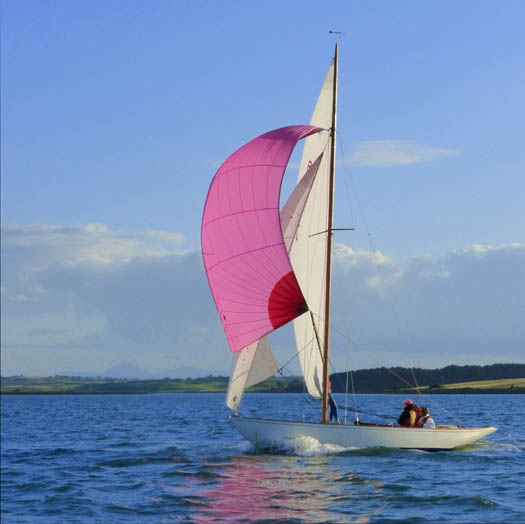
The essence of Strangford Lough – a River Class sloop sailing well, and the timeless view beyond across County Down to the Mountains of Mourne. Photo: W M Nixon

If dodging tides by going close inshore is your thing while using every little twist to the wind, then racing Rivers on Strangford Lough is just for you. Photo: W M Nixon
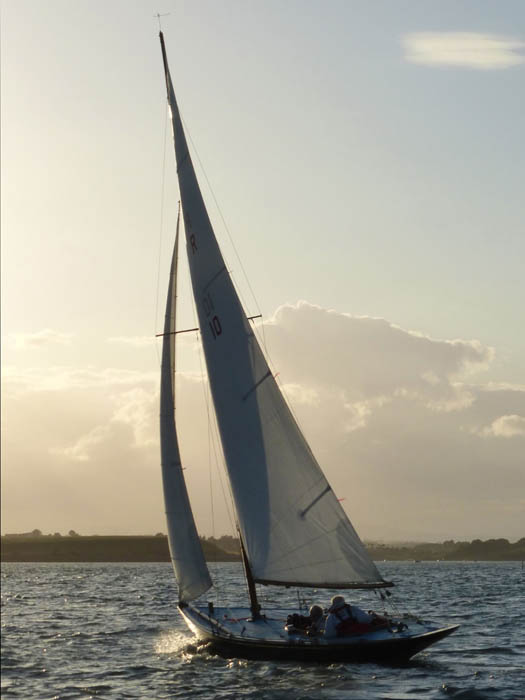
In harmony with her surroundings, a River Class sloop makes her elegant way afloat. Photo: W M Nixon
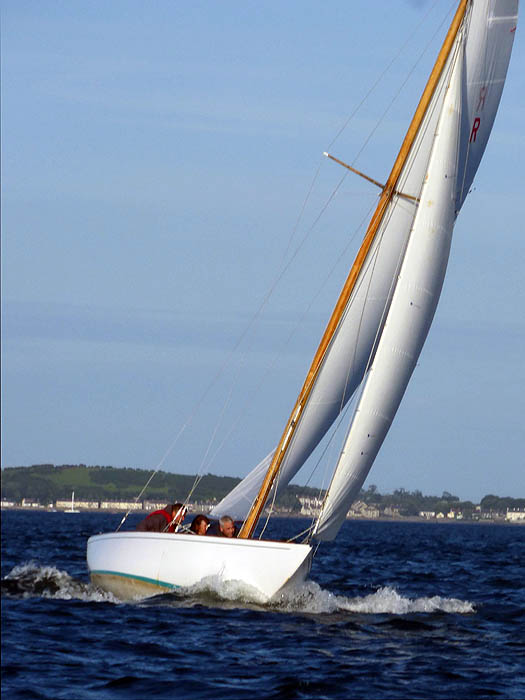
When there's a bit of bite to the breeze, it's impressive how much power the conservatively-canvassed River Class sloops can develop. Photo: W M Nixon
But though the rig may have spoken volumes – it's believed to be the first Bermudan-rigged one design – there was no way that the great Alfred Mylne, the man who reputedly drew the lines of Britannia in 1892-93 as a trainee naval architect in G L Watson's Glasgow office, was going to design anything other than a good-looking boat. Admittedy, with her cockpit well aft, there can be times when a River seems to sit on her stern if her crew are more interested in comfort than boat trim. But when she's sailing on her designed lines, she's a joy to behold, and with her heavy but harmonious hull, she can carry her way in impressive style, making tacking a nicely judged and elegant manoeuvre if it's done right.
In all, a dozen Rivers have been built, most of them before 1923, while the class started racing in 1921. At first, they shifted their racing venues between Belfast Lough and Strangford Lough, as the owners were mostly members of Royal Ulster YC at Bangor. But from time to time they liked to moor their boats off their shoreside big houses on Strangford Lough, usually with their estate gardeners being roped in for additional duties as boat delivery crews sailing between the two loughs along the often rough North Channel coast of the Ards Peninsula. The very thought of it might easily turn anyone into a firebrand revolutionary.
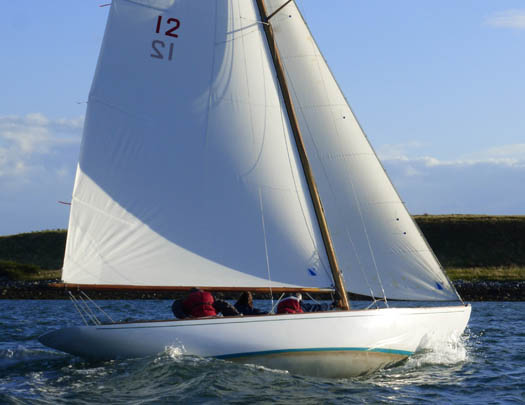
The River was designed by Alfred Mylne in 1920, and shows some family resemblance to the Mylne-designed Dublin Bay 21s (1902) and Dublin Bay 24s (1937), while still being very much an individual in her own right. Photo: W M Nixon
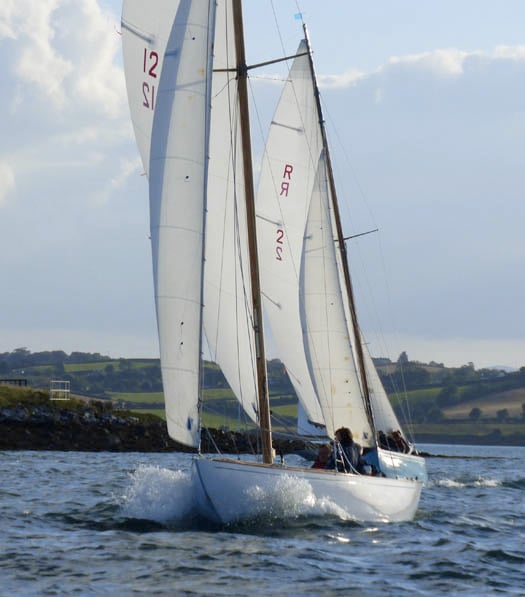
Thanks to an adequately-sized rudder of only moderate rake, it is possible to race the Rivers at close quarters with confidence. Photo: W M Nixon
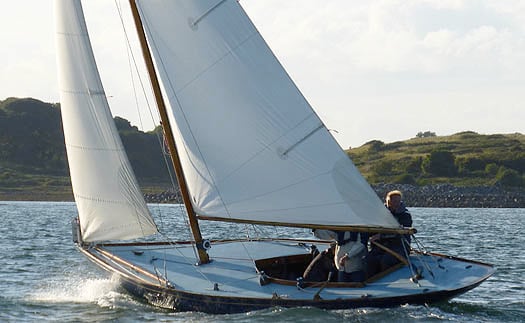
As the Rivers don't set genoas, the correct trim of the little jib is absolutely key to racing success. The class has strict rules about replacing sails only as a group in order to maintain one design performance. Photo: W M Nixon
Be that as it may, gradually the focus moved completely to Strangford Lough, and for a while the class had such a preponderance of aristocratic owners that you could be forgiven for thinking it was P G Wodehouse's take on yachting. Typical were Lord and Lady Londonderry (they pronounced its London-dree), with their seat at Mount Stewart on the lough's eastern shore.
They argued so much aboard their River that they had to get another one so that Lady Edith could race against her husband. In the late 1930s, when she began to favour a policy of Appeasement with the resurgent Germany and flirted with Hitler's Nazis, she invited the Nazi big cheese von Ribbentrop to stay at Mount Stewart and sail with her in a race off the house aboard her River, which was duly T-boned during the event by her husband in his boat.
That was about the height of international excitement and celebrity for the Rivers. By the end of the 1930s, the class had become based at Whiterock with the new Strangford Lough Yacht Club, and the only time they subsequently emerged blinking into the outside world was in 1951 when they sailed as a group to race in the Festival of Britain Regatta Week on Belfast Lough, where the supreme champion by a mile in the River racing was the young Barry Bramwell sailing his family's boat Roe. His subsequent stellar sailing career included winning many dinghy championships, and he skippered a boat for Ireland in the Admiral's Cup.

Although the River Class have not sailed outside Strangford Lough since 1951, their close competition at home has produced some notable performers in other boat types. Photo: W M Nixon
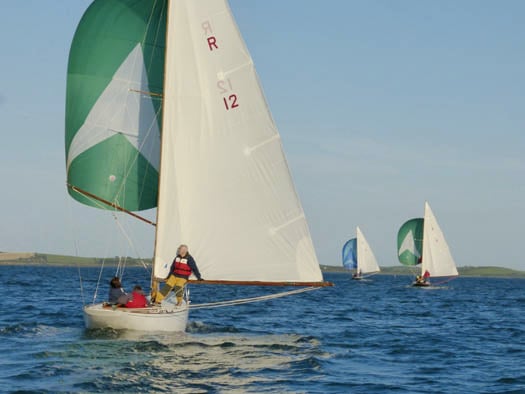
Rivers on the run, and looking very handsome with it. The class has decided that having a kicking strap would not be in the spirit of the design, so having a crewman seated on the boom on a dead run is standard practice. Photo: W M Nixon

With the crew up forward under the deck, and only the helmsman aft in the cockpit, Brian Law's Uladh (10) is perfectly trimmed for best performance to windward. Photo: W M Nixon
The Rivers meanwhile returned home after the Festival Regatta Week, and since 1951 the nearest they've ever got to the open sea is the annual visit to the time-honoured Narrows Regatta between Portaferry and Strangford for a few days in July. Otherwise, they might sometimes be seen at local regattas at the Quoile, Killyleagh and Kircubbin. But for the most part, they stay in stately seclusion at Whiterock and enjoy a compact annual racing programme. This may seem to be only relatively few races to those from other hyper-keen local one design classes. But after 93 years, the Rivers have become such an integral part of the fabric of sailing at Whiterock, and such a central part of community and family life for those involved, that you don't need a huge number of races for each season to be a success, what's needed is the savouring of the moments afloat on a summer's evening, and then an analysis of each race in loving detail in the friendly clubhouse afterwards.
With the GP 14 Worlds coming up on Strangford Lough this past week, there was an ideal opportunity to contrast two forms of sailing there. I'd already tried to get some River Class photos on an evening earlier in the season by signing up to sail as fifth hand aboard Brian Law's Uladh (the von Ribbentrop boat). But when we all assembled, it emerged - in typically Strangford Lough style - that the helmsman was delayed by the need to get his wife and daughter's vintage horsebox through its MOT test, so I was stuck on the Tiller That Von Ribbentrop Held.
Despite that, the boat was a joy to sail in a light summery shirt sleeves breeze, but it resulted in damn all worthwhile photos on the disk. So this week, Brian and another River owner Kenny Smyth, Vice Commodore SLYC, arranged for Chris Boston, whose hobby is being a sort of Honorary Boatman at Whiterock, to take me out to buzz around the racing fleet on an August evening with a decent though fading northwest breeze, and Chris did a super job.
My camera is just a clever little Lumix, which is a Leica lens with a sort of digital Box Brownie stuck on the back. So please excuse the fuzzy telephoto shots, but the photos speak for themselves – the Rivers are good looking classic boats which provide great sport. These days, the Smyth brothers Kenny and Graham are setting the pace, which suggests sailing enthusiasm of a high order. Their day job is running the characterful little boatyard immediately south of Whiterock, an establishment created by their legendary father Billy who introduced his family to cruising through extensive ventures in the former Manx fishing boat Aigh Vie (see this blog on 29th March 2014). Whatever way Billy Smyth did it, he imbued his sons with such enthusiasm that they can spend their working day being busy fixing somebody else's boat, then go out and sail their own boats with equal dedication in the weekly evening race. And they're more than generous with helpful tips to their opponents on tactics and tuning.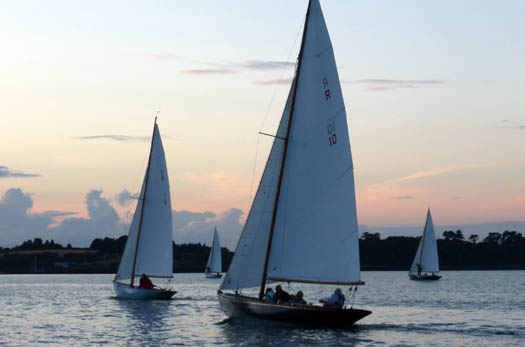
When they talk of "twilight racing" in the River Class, they really mean it......Photo: W M Nixon
Having spent an entertaing and very complete evening with the classics that were designed so that they could be sailed by a man and his daughters, next morning found me contemplating a hundred dinghies to a 14ft design which was originally envisaged as a useful and versatile little boat to provide "affordable fun afloat for Pa, Ma and the kids".
Like the River, the GP 14 emerged in a post war situation, but in 1949 the mood after World War II (1939-45) was much more egalitarian than it had been in 1919. The General Purpose 14 was the brainchild of Teddy Haylock, the Editor of Yachting World magazine in London, and it was one of the first in a series which became the YW Build Her Yourself boats, mostly designed by Jack Holt with DIY plywood kits supplied by Bell Woodworking Co.
Haylock still carried his wartime title of Group Captain E F Haylock after a "good war" with the RAF, but he had a very clearcut view of how things should go in peacetime. If his projects sometimes seemed to be delivered in a slightly patronising tone, there's no doubt his heart was in the right place, even if some of his posher advertisers weren't at all pleased by his glossy magazine devoting so much energy to people who hoped to self-assemble their own boats rather than buy a complete and expensive one from an established yacht builder.
To say that the GP 14 succeeded beyond anyone's wildest dreams is under-stating the case. Though the 14,000-plus boats built worldwide have been used for general purposes, they're primarily racing boats these days, and it was this which brought a hundred of them to the well hidden East Down YC in behind Island Taggart on Strangford Lough's west shore just north of Killyleagh.
Back in 1970, most folk thought that just about every possible sailing club site on the shores of Strangford Lough had been earmarked and developed. But the founders of EDYC discovered this place, which was accessible by land only along a narrow unpaved track going so close to the edge of a farmyard that it almost goes through it. In those days before 4X4s were ubiquitous, you really did need a Landrover to get to the new waterfront location with any certainty. But over the years the club has expanded its clubhouse and its facilities ashore with an extensive dinghy park, while the keelboat fleet linked to the club includes former Commodore Jay Colville's First 40 which took part in this year's ICRA Nats in Dun Laoghaire.
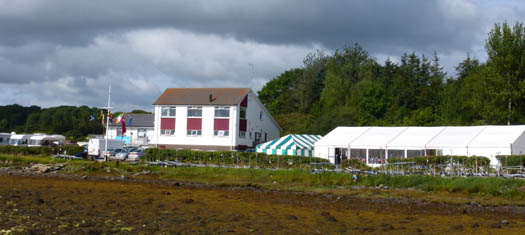
East Down YC, venue for the GP 14 Worlds 2014. Photo: W M Nixon

Somehow or other, the founders of EDYC in 1970 managed to shoehorn their substantial clubhouse with its large dinghy park into a previously unused waterfront setting accessed via this narrow lane. Photo: W M Nixon
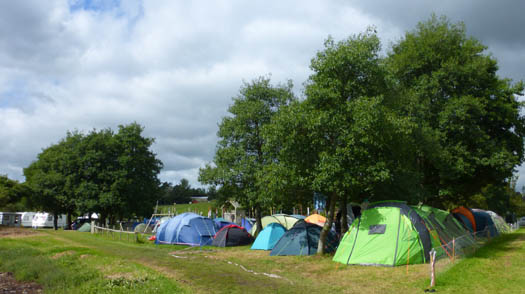
All that GP 14 sailors require is somewhere to pitch their tent........Photo: W M Nixon
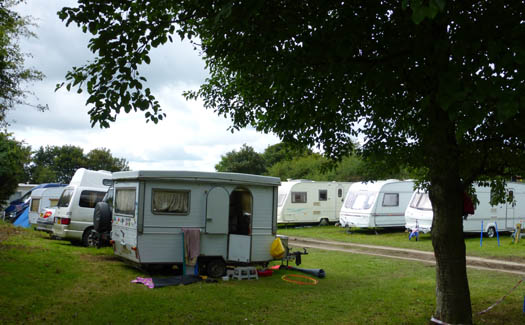
...or park their 'van. Photo: W M Nixon

Graham Wright of EDYC gallantly took on the challenge of chairing the Organising Committee for the GP 14 Worlds 2014 with just two years to go to the off. Photo: W M Nixon

The kind of headlines that any organisers dread. Yet EDYC were quite rightly so confident about their proper handling of the weather problems that they subsequently displayed this newspaper spread in the main marque. Photo: W M Nixon
Taking on a Worlds is a formidable challenge for any club, and when it's the Worlds of a dinghy class which is as important in Ireland as the GP 14, the pressure is greater still. It was as recently as 2012 that East Down was approached by the Irish GP 14 Association as they realised other avenues were being closed off in their search for a willing club for their allocated staging of the Worlds in 2014, and the club deserves an award for courage in taking it on, setting up an Organising Committee under Graham Wright and getting the show on the road.
I'd a telling instance of just why the GP 14 is so relevant recently while heading through Youghal, where three dinghy masts were visible above a harbourside wall. On the other side of the wall was one of those little mud-filled docks which are such a feature of Youghal's waterfront, and sitting serenely on the mud were three GP 14s.
What else could they have been? As I was to discover at EDYC, the GP 14 is central to building up the sailing club at Youghal, and at many other clubs all round the country too. While some members may try more glamorous boats from time to time, the GP 14 ticks most boxes in terms of versatility while setting a spinnaker, having an effective class structure, and providing racing at all levels.
My own links to the class go back to the 1960s when the sailing club at Queens University in Belfast suddenly found itself supplied with funds for a new boat or two provided the boats were built within a specified time. Although club captain, I was already a dedicated keelboat man except for the annual foray into Fireflies racing against other colleges in Dun Laoghaire and England & Wales. In other words, I knew nothing. However, our Honorary Secretary Mike Balmforth was a very switched on guy who had built his own Enterprise with his father. But as QUB already had a couple of old GP 14s, he soon decided that we could get the boats built on time – and they'd be GP 14s as required - by a relative newcomer to boatbuilding called Gerry Duffin, a former housebuilder and carpenter who had his workshop in East Belfast and was starting to fulfil his dream of building boats.
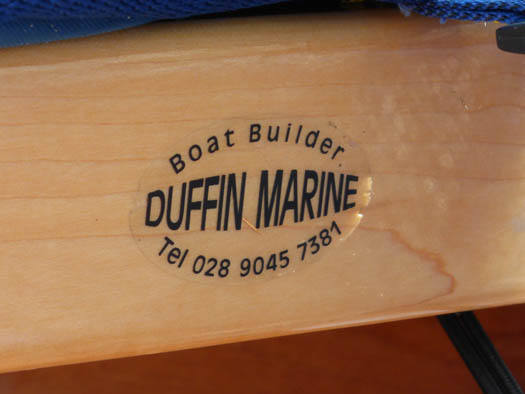
The sign of success – the home firm builds the best GP 14s in the world. Photo: W M Nixon
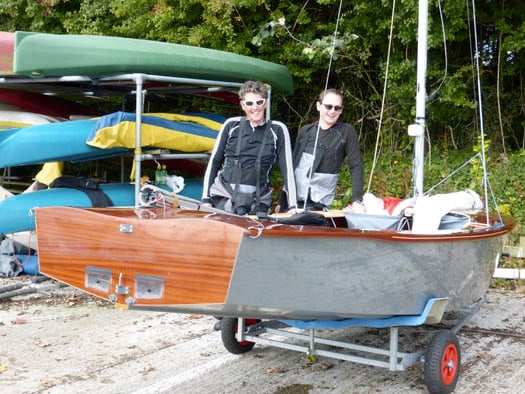
The "Duffin dip" in the transom of the newest boat for the Lough Foyle fleet. Photo: W M Nixon
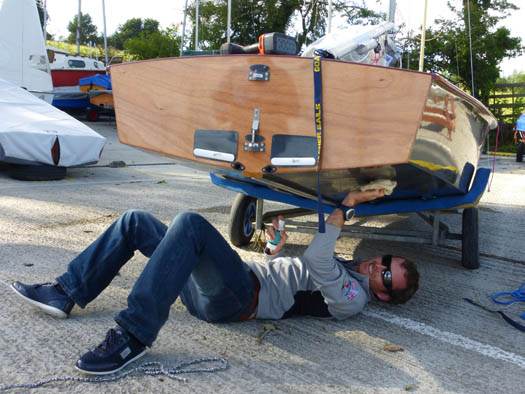
"If you want to be sure it's done properly, then you have to do it yourself" Top contender Ian Dobson putting in some work on the hull finish. Photo: W M Nixon
One rainy day we went across town in Mike's rickety Austin 7 (its wooden frame was supported by Spanish windlasses utilising electric cable instead of rope), and there in the shed was the first of the new boats. It was a very old shed, and there were several leaks which prompted Gerry to quip that he really should get the builders in. But to our young eyes, there was nothing to see but this lovely new GP 14, an early product of a line which continues to the present day, for at East Down YC this week all the main contenders, and indeed the majority of the fleet, were Duffin built, with Duffin Marine for many years now being run by Gerry's son Alistair.
Like the Smyth brothers up at Whiterock, his enthusiasm is almost certifiable, as he not only builds the best GP 14s for everyone else, but he also races keenly with the class. And though the rules are strict, he is always trying to find ways of innovating his products, which are more like collector's furniture than boats.
In recent years, he has tried to persuade the class to let him take out most of the transom in modern style, but when an open transom was declared verboten, instead he introduced the "Duffin dip" in the afterdeck. When asked why, his answer was that he just keeps trying to reduce weight. Whatever, people certainly love his boats. I was at East Down briefly in late afternoon on the layday on Wednesday, and though there were few folk around, down at the end of the dinghy park was top contender Ian Southworth beavering away at his beloved Duffin boat.
The mood was distinctly relaxed with the club and the class well recovered from he unexpected wall-to-wall attention they'd received on the Monday. A couple of nasty squalls – yet another by-product of the slow progress of former Hurricane Bertha across northwest Europe – had resulted in between ten and twenty boats having some difficulty in coping with being capsized. But the Championship safety team were handling it competently when it was declared an Emergency Situation by some Powers That Be. Almost immediately those narrow roads and single track approaches to the club were jammed with ambulances and a fire brigade as helicopters gyrated overhead.
While some newspapers sought only to have shock headlines, it has to be said that when the scale of the over-response became evident, it was heartening to see how the better strands of the media responded to it all with an intelligent and friendly interest in what was going on. They were fascinated by how an event which was classed as a World Championship was being staged, and staged so effectively too, at the end of a tree-lined single-track lane in remotely rural County Down. In the end, the clear egalitarian nature of GP 14 racing and the calmness of the people involved reflected very well on the image of our sport. And as for the multiple rescue and emergency services, they had all the benefits of a "for real" exercise which might prove to be very useful in the unlikely event of a passenger jetliner ever coming down among the islands of Strangford Lough.
The atmosphere may have been serene in the late afternoon of the layday, but next morning with three races scheduled in a brisk nor'wester, the club compound was hectic enough for anyone. And the layday did the trick – as one of the International Jury remarked, it is very unusual at any Worlds to see the entire fleet put to sea two thirds of the way into the event, but they poured down the slip and away out round the island, and at the end of it there wasn't a boat left ashore.
But by that time I'd had every opportunity to observe the spirit of the GP 14s, and it is formidable. Ireland has a great record in the class, with Bill Whisker of Ballyholme becoming a World Champion, while others like Paul Rowan of East Antrim and Pat Murphy of Clontarf were in the international frame for years.
Yet these days the class is as keen as ever in encouraging new blood and establishing a firm foothold at new clubs. That glimpse of a nascent GP 14 class at Youghal well illustrated the point, and it was Norman Lee who told the story. I'd spotted the famous vintage camper van which is the campaign base for GP 14 legend Norman Lee of Greystones, who is crewed by his brother Ken and supported by Norman's wife Una and their two collie dogs - dogs on campaign are very much a GP 14 thing.
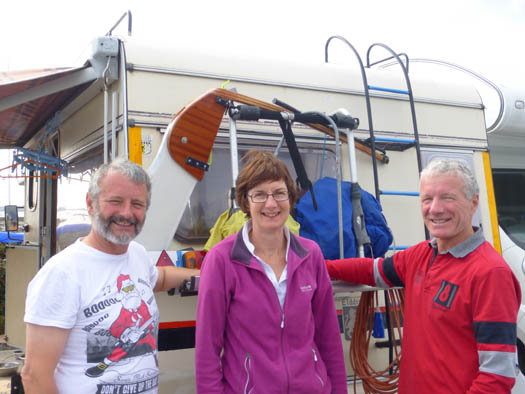
The Lee team from Greystones with their vintage campervan are Ken (left), Norman (right) and Una. Photo: W M Nixon
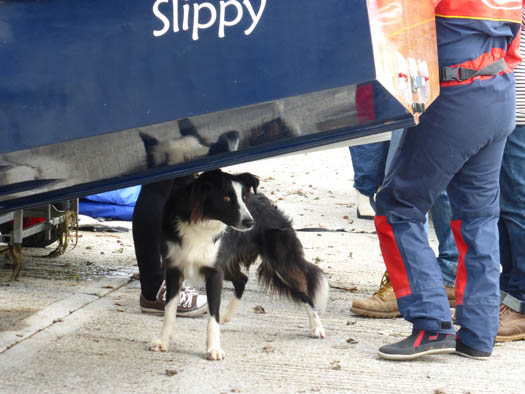
If you're going to have a GP 14.........Photo: W M Nixon
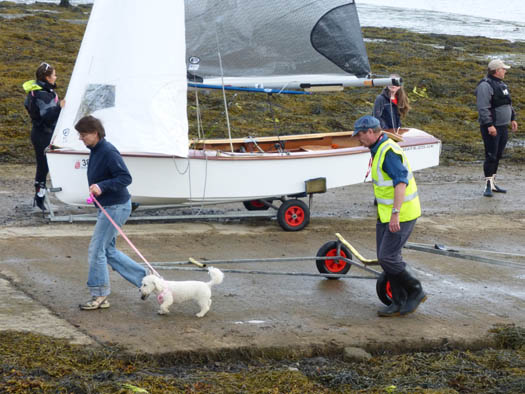
....then you have to have a pooch. Photo: W M Nixon

...and while most breeds are allowed, a collie variant is preferred. Photo: W M Nixon
The Lee equipage was in fine form, having taken a useful second in one of Tuesday's races, but as soon as I mentioned the presence of the Geeps at Youghal, all that was forgotten as Norman enthused about the growing club there, and what he and the class are doing to get Youghal's GP fan Adrian Lee (no relation) and his group further down the road.
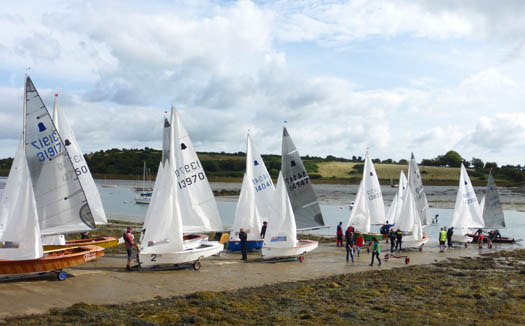
Getting a hunded boats away is a formidable challenge..... Photo: W M Nixon
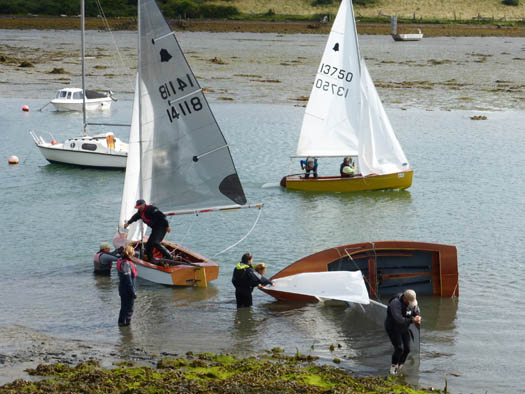
....and the last thing you need is somebody deciding last minute adjustments are essential.......Photo: W M Nixon

....when they're still joining the queue at the top of slip. Photo: W M Nixon
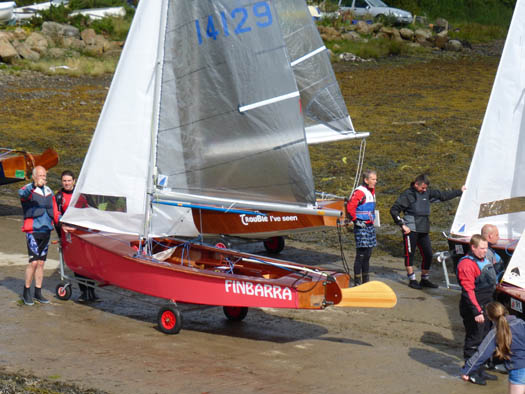
"Don't these guys holding us up realise that they're delaying a whole line of renowned international athletes.....?" Photo: W M Nixon
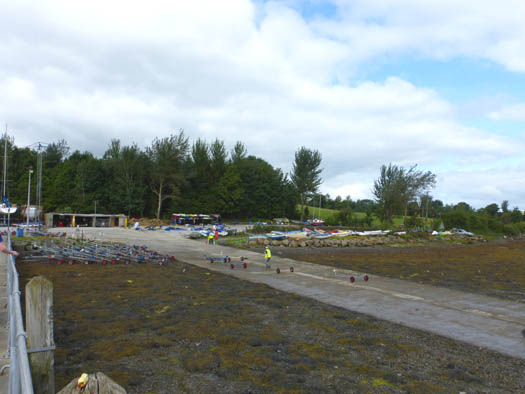
Suddenly, they're gone – every last one of them. This is one very keen class. Photo: W M Nixon
Or more accurately, further up the river. Norman and other GP 14 sailors are fascinated by the possibilities of the mighty Blackwater River which reaches the sea at Youghal. Already, they have had a trial distance sail from the estuary right up to Cappoquin, and this has fired them up so much that they're going to make it a major event when they repeat it in the last weekend of August in order to give Youghal SC a proper re-launch. Their enthusiasm has so fired up others that top GP 14 racers like Ger Owens from Dun Laoghaire have said they'll go, as have crews from the growing fleets on Lough Foyle, which is wellnigh as far as it's possible to be from Youghal without leaving Ireland.
It may all seem a bit far-fetched. But believe me, when you're in a large dinghy park at the end of a small farm track in the depths of County Down, and when the event photographer has just gone aloft in a small aircraft because that's the best way to get snaps of a major dinghy event out in the middle of Strangford Lough, then long distance dinghy sailing events from Youghal to Cappoquin seem eminently feasible.
Flying Fifteen DBSC Race Won By Frequent Flyer
#flyingfifteen – 13 Flying Fifteens turned out for the DBSC racing last night, on arrival the wind had faded completely and it looked like we might get the night off. As the fleet headed out to the start area a new wind filled in from the NE and there was a nice force 3-4 wind with the tide flooding.
The race was won by Chris Doorly & Alan Green in Frequent Flyer who now lead Series 2. The pin end was biased and in the scramble Colman/Quinn in Flyer popped out just ahead of Doorly, Mulvin and Galvin. The individual recall flag went up, Mulvin did go back but was he the only one? As usual the culprits would not all be known till the end of the race. As we were heading out to Zebra most boats tacked out to sea on starboard. Colman, Doorly and Murphy went to the left side where there seemed to be more wind. These were the first three at the weather mark closely followed by Galvin and the new Mulligan/ Sherry combination.
There were great reaches down to Harbour and then Bullock marks, Colman and Doorly had pulled away but Galvin was up to third place and further back Mulvin was working his way through the fleet after going back at the start. It was a beat out to East, Colman kept to the right as did Doorly but Galvin went more left and closed the gap.
Again there was a lovely reach down to Pier, Colman kept ahead and after rounding headed towards the harbour wall to the left, had he over stood the finish line? Doorly sensing an opportunity to make the finish line tacked straight away. This was going to be close, both crews were working hard to keep the boats at full speed. Colman was able to reach down a bit and crossed the line . . . a deafening silence, no hooter! Doorly
& Green then crossed the line to the sound of the hooter. Galvin was third with Hugh & Michael Cahill third and Mulvin fourth. A most enjoyable race and thanks to PRO Jack Roy and his team in Freebird for an excellent course.
A thought for the day is that although sailing is generally self policing maybe there is a case to be made for calling out the numbers of boats OCS over the radio, not for the benefit of the boats over the line but for the benefit of those who are not over the line and sailing within the rules.
It's a busy week ahead, DBSC racing on Saturday with the Captains prize on Sunday followed by the Championships of Ireland in Portaferry next weekend.
New Flying Fifteen Winners in DBSC Series
#dbsc – 12 Flying Fifteen turned out for the DBSC racing on Saturday the last Saturday of the second series, there was a pleasant force 3⁄4 W wind with the tide ebbing. What transpired was a total mix of conditions from over 20 knots to zero and the results were just as topsy turvey with the first three in the first race in the last three of the second race!
There was even a number of retirals due to gear damage including Ian Mathews (forestay toggle) and Dave Gorman (jibs sheets), So we had some new winners, Tom Murphy sailing with Tom Galvin in Race 1 and Peter Sherry sailing with Mick Quinn in Race 2.
The first race set of in a steady force 3, Murphy was on the pin which was biased, others including Maguire/Burgess in SnowWhite went right. Gorman did a short tack into the middle and got steady breeze and lead at the first mark closely followed by Coughlan/Marshal in Ash with Maguire, Murphy and Dumpleton close behind. At the leeward mark the dark clouds were looming but it was still relatively light. Gorman, Coughlan and Mathews went left while Murphy and Maguire went far right. The wind was shifting to the right the whole way up the beat, Gorman cut his loses but in the now strong building wind it was Murphy and Maguire at the weather mark followed by Gorman, Murphy did a spectacular broach allowing Maguire and Gorman through, planning downwind Gorman took the lead but Maguire was snapping at his heels till Gorman went more right on the waves and got away to lead at the leeward mark.
Meanwhile back at the weather mark the wind was a force 4-5 and Mathews forestay went and that was the end of his race and brand new Alto mast!
There was more to come, as Gorman went up the beat and tacked on the lay line his jib sheets unravelled and the block popped off- end of race for them. This left Maguire and Murphy battling it out right to the end where Murphy did a tidier mark rounding at the last leeward mark. Third was Dumpleton. Race two followed, by this time the wind had died off completely. Dumpleton lead the way but the course was shortened after one lap and finished downwind on the run.
At this stage the wind came from a different direction, those at that side of the course gained and Peter Sherry, John OSullivan and Joe Coughlan came through as the others could only look on in frustration.Despite the results Maguire/Burgess won the second series with Murphy secend and Ken Dumpleton and David Mulvin third.
With the Championships of Ireland on in Portaferry in two weeks it was better to have the gear failure now, also a reminder to others to check their rigging!
#flyingfifteen – Once again the Flying Fifteens were all greeted by a bank of fog when they arrived in Dun Laoghaire writes our special correspondent. It didn't look like we would get out sailing especially as the 250 Optimists had just been brought ashore after several hours on the water. The PRO made a great decision and postponed racing for an hour, this does not happen very often in Dublin Bay, long may it last! The fog moved back out to sea and we got racing in Seapoint Bay. There were fourteen boats out and the Flying Fifteen race was won by Justin Maguire & Frank Burgess in Snowwhite with Ben Mulligan & Chris Doorly teaming up in Mellifluence a very close second.
The winds was generally light, force 3 or less, from E/SE with a strong tide going out, it seemed logical to go right out of the tide but just before the start the wind filled in over the course so last minute decisions had to be made. The majority of boats headed in towards the shore on the right but Maguire and Mulligan kept going out to see in the wind, Maguire tacked about half way up, Mulligan kindly allowing him to cross on port as he wanted to go further out. Maguire crossed all the boats but when Mulligan came across the pressure dropped slightly and Murphy and Donleavy crossed, Mulligan tacked for the mark as the other two crossed him again but they overstood the mark allowing Mulligan to stay second behind Maguire with Donleavy, Murphy and the Meaghers all close behind.
It was all very close going downwind but Mulligan did a good rounding at the leeward mark as Donleavy was ready to pounce, but his spinnaker halyard got stuck and that was that! Maguire had a good lead, as all boats generally headed towards the pier it seemed a soldier's race. Maguire kept going in and eventually joined the stacking of other squibs and dinghies above the layline, Mulligan tacked early and had a clear lane up to the weather mark, there was now only one boat length in it. Downwind it was close with Maguire watching to see if Mulligan would attack, nothing significant happened as Mulligan waited for the leeward mark, there he just got his nose between Maguire and the mark but Maguire held on and survived a tacking duel up to the finish line to deservedly win but it was close! Meanwhile at the leeward mark the Meagher's got past Gerry Donleavy & Alan Green to take third place.
Well done to the PRO Brian O'Hara and his team for getting a race in on a difficult day.
Frequent Flyer Comes Through the Fog in Dublin Bay
#flyingfifteen – On one of the warmest days of the summer Flying Fifteens were all greeted by a bank of fog when we arrived in Dun Laoghaire but there was enough visibility particularly in Scotsman's Bay to proceed with the race. Last night's Flying Fifteen race with fifteen boats out was won by Alan Green & Chris Doorly in Frequent Flyer but the lead did change several times during the race.
The winds was generally light, force 3 or less, from the SE with the tide going out, the pin end was slightly favoured and Tom Murphy got a good start on the pin with Colman, Dumpleton and Green just above him. Green was forced to tack off, this was no harm as everyone was distracted looking for the mark in the fog. When Green went back out Coleman and Dumpleton crossed him but at the mark it was all very close with Peter Sherry also in the mix. Green rounded the mark first but was quickly over taken by Colman and Dumpleton who sailed higher, Green not being able to see the next mark in the fog!. It stayed this way for the next two marks and on the next beat Colman went right and lost the wind, Dumpleton went left but lost some ground as an SB20 who didn't know his rules sailed down on top of him. Meanwhile Green went left of middle in clear air and came out first at the weather mark, down the run to Pier Colman and Dumpleton gybed towards the shore, Green covered them but soon realised the error of his ways and gybed back to the right as there was always more breeze out to sea.
Alan Dooley had caught up and when Green couldn't get his spinnaker down he went the wrong side of the mark as Dooley took the lead. On correcting himself he stayed second. On the final beat up to Poldy Dooley tacked and went towards the shore as Green went more out to sea, as it had all night this paid and he had the lead at the mark, then it was a very light sloppy run/reach down to the finish at harbour mark. The boats were still all very close, Mulvin had moved into second place now followed by Dumpleton, in third, Leonard fourth with Dooley now in fifth place. This is how it finished.
Well done to the PRO Jack Roy and his team on Freebird for getting a good race in on a difficult night. This Saturday the DBSC series continues.
.
#flyingfifteen – The last of the waterfront clubs summer regatta's took place at the RStGYC on Saturday and the Flying Fifteen class was won by Dave Gorman & Chris Doorly in Betty in testing conditions as the winds were all over the bay. This gives them the 'grand slam' as they won all four waterfront regattas. Second was Ian Mathews with Jonathan O'Rourke helming on the same points as Adrian Cooper & Joe in Gulfstream in a well deserved third place.
It was forecast to be windy from the west, something we havnt had for a while but during racing the prevailing wind was fighting with the sea breeze and the usual hole appeared in the Bay giving a testing time to the competitors and the Race Officers.
In race 1 there was a bias to the pin and there were about 12knots under the big dirty cloud above so full hiking was the order of the day . . for a while at least! O'Rourke/Mathews led the way after a good start at the pin, as the boats tacked onto port there was a shift and a change in wind strength, those on the left were knocked and the two boats that had gone right were coming in full steam with Ken & Maryjane leading at the weather mark from O'Rourke, Justin Maguire and Adrian Cooper, Gorman was fifth to the weather mark. On the reach Gorman sailed low to try and get some place by getting water at the next mark, this worked well and at the gybe mark was second. The wind was holding, O'Rourke went to the right of the second beat along with Adraian while Gorman and Maguire went left, by now the wind was getting lighter and flukier. Maguire & Burgess made big gains and tacked in under O'Rourke at the weather mark but were sailed over, Gorman was fifth. Downwind Gorman went right hoping for that sea breeze and the help of the incoming tide, it looked good for a while as those on the left had no wind Then the wind gods gave those on the left wind and took it from the right! As the boats neared the leeward mark the wind picked up for a few minutes. As Gorman went left on starboard he got tangled with a port Fireball, for the last lap the positions didn't change so O'Rourke won from Justin & Frank with Gorman third and Adrian & Joe fourth.
There was a very long break between races as all classes were given 3 laps, this is preventable if the first couple of classes are given an extra lap. With the winds now more easterly the PRO reset the course, due to the uncertainty it was to be a shorter two lap course- this proved to be an inspired decision!
To have any chance of winning the regatta Gorman had to win and hope O'Rourke and Maguire have a poor race, this was unlikely but you would never know. The Meagher's were also out to add to the mix for the second race after having a lie in! In race 2 the wind was up and the pin end was biased, O'Rourke got the pin, with Colman to his weather, Gorman started away from the pin and managed to trap the two boat below, as in last week regatta there was actually very little time to be on starboard ,Gorman went a little beyond the lay line and O'Rourke and Colman had now overstood the mark and were in Gorman's dirt. As he approached the weather mark the boats from the right were coming in on starboard, Gorman got in about two boat lenghts in front of Alan Dooley and Adrian Cooper with the Cahills close behind. There was a bit of heavy traffic at the weather mark and O'Rourke and Maguire got caught up in it as Gorman increased his lead. On the second beat Dooley was sailing well on the right, the wind had now dropped and anything could happen, Gorman was in the middle but headed slightly right and was relieved to get around the weather mark intact- the rest were not so lucky. It was a beat now on the run, Gorman went left to the forecasted wind from the west and kept moving in the light winds, the beat to the finish was a run. Dooley stayed second with Adrian third, the Cahills fourth and the Meagher's fifth with O'Rourke in sixth place and Maguire behind them. So the regatta was won in difficult conditions where anything could happen and anything did happen.
Once ashore it was down to the RStGYC for the usual regatta festivities and prize giving, the club had a great bbq with super food and live music. Next week its back to the DBSC series.
Flying Fifteen 'Perfect Ten' Steals The DBSC Show
#flyinfgfifteen – The wind gods were toying with the Flying fifteens last night and depending where you were you had zero wind up to about 10knots towards the end, despite a good forecast with a steady building wind from the SE it was always a surprise to what direction it came from last night.
The course was set up by Jack and his team and it was to be a short beat to East mark with the pin favoured, this was reinforced as we watched the SB start. Chris with Valerie Mulvin crewing and Ben & Maryjane crossed the fleet and were looking good, then from below Joe and Tom Murphy sailed around the leaders to take the lead . . or so they thought!
As Tom tacked for the mark he ended up pointing northwest back towards Dun Laoghaire. Meanwhile Chris and Ben seemed to redeem themselves as they pointed east towards the mark. At this stage those on the left got their own private breeze and Adrian, the Cahills and Alan Balfe came into the mark to be confronted by the Dragons and Sb's coming from the right with spinnakers up . . figure that one out! Those in the middle had little or no wind but and this led to a dangerous situation with all the inside boats coming in demanding their rights at the mark. The boats with no wind had no time and opportunity to get out of the way and some very poor seamanship was shown by some of the bigger boats, a dragon was actually spotted in Alan Dooley's boat!
Eventually everyone got around and headed to Omega, out of the mess Alan Balfe & Karl Lynch led the way hotly persued by Hugh & Michael Cahill with Adrian & Joe next. This is the way it finished as very little changed after that as the next four legs were all fetches. Alan Dooley & Joe Hickey recovered to be fourth after disentangling himself from the dragon earlier. It may take others longer to recover and get their heads together. So well done to Alan and Karl, it was Karls first ever win in the class!
Hopefully they can keep the good form for the RStGYC regatta at the weekend where there should be some great racing in a good sized fleet assuming the wind gods will be kinder to us As usual it will be fiercely contested, Dave Gorman & Chris Doorly may be slight favourites as they will be looking to complete the grand slam of the four waterfront regattas.





































































